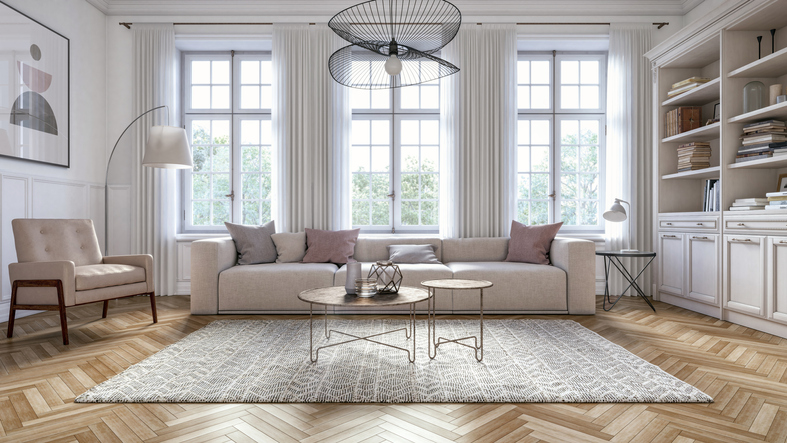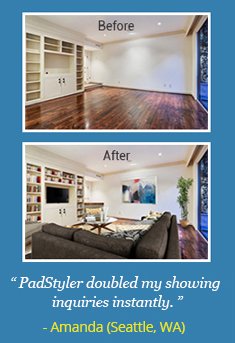
Staging a home for sale has been a tool used by real estate agents and sellers for years. When a home is beautifully staged, it can be a real lure for potential buyers. The process of home staging involves a lot of heavy lifting, rearranging furniture, and intense attention to details and decorating. Most buyers prefer to purchase a home that looks well-kept and on-trend, which makes staging the property a smart marketing move. However, a lot of physical work, time, and effort comes with the staging process and it doesn’t mean that a quick sale is guaranteed. Virtual staging uses the same principles as regular staging, but with a technological twist. This process can save you a lot of headaches while still providing you with amazing results.
What is Virtual Staging?
When a buyer opts to use virtual staging, the stager takes digital photos of the home. The property could be empty, or it could even be full of mismatched furniture, knick-knacks, and clutter. Once the photos are taken, the virtual stager uses special photo-editing software to “tweak†the way the home looks. This software can remove unwanted clutter, remodeling being done and furniture with a few commands. It also allows the stager to add anything they want including new matching furniture, décor, and more. Extreme care is taken to ensure that every room of the home appears as if it’s been physically staged. The final photos are then posted on the listing, giving sellers a chance to entice new buyers to make a purchase or schedule a showing.
How Does Virtual Staging Work?
Today’s modern home buyer tends to look for property online before they even set foot in the door. Most buyers want to get an idea of the home’s size, design, and aesthetics before they take their valuable time to physically go to a showing. With virtual staging, software is used to create a beautiful home remotely. The seller doesn’t have to lift a finger (in most cases) and the virtual stager simply works their magic once the photos are obtained. This advanced software allows the stager to brighten up a room and add new furniture, rugs, and even artwork. The process requires skill and training in order to ensure that the final product looks polished and realistic. Through the use of shadowing and other techniques, the final photographs of the home offer buyers a beautiful perspective that entices them to learn more. With so much digital marketing being used for real estate sales today, it’s not surprising that this new method of home staging is becoming more popular than ever before.
Virtual vs Traditional Staging
Traditional staging involves a professional stager coming to the home and assessing how it looks in order to make changes that will get the home sold. The stager will measure each room and take photographs to help them determine what items are needed. Once the home is ready to be staged, they’ll bring in furniture, rugs, and accessories. If the home is currently furnished, the stager may ask the seller to remove the furniture and put it in storage. In some cases, they may be able to use a few existing pieces while in others, the stager may ask the seller to take everything out. This process requires a lot of extra work, time, and expense on the seller’s part and it can be especially difficult if they’re still living in the home while it’s staged. An empty home is much easier to stage, which is why most traditional stagers require the property to be emptied out before they bring new items in.
With virtual staging, the seller doesn’t need to move furniture or empty out rooms. All the virtual staging company needs are clear photos of the home including the bedrooms, living room, bathrooms, and kitchen. Most virtual stagers will come to the home to take professional photographs, but as a seller, you may be allowed to submit them yourself. Discuss the options with your virtual stager to find out what they prefer. Clear photographs of the entire room must be taken in order for the virtual staging to be effective. However, this process is much more convenient for the seller since they won’t need to physically move anything or pay for a storage facility. They also won’t have to worry about making sure that everything is perfectly in place since all of the new furniture is virtual and not actually in the home.
Pros and Cons
As with any professional service, there are pros and cons to virtual staging. Let’s take a closer look at the benefits and some of the drawbacks:
Pros
- Virtual staging is much easier on the seller since they won’t need to remove or move any furniture or pay for separate storage while they wait for their home to sell.
- Cost-wise, a virtual staging service is usually a lot less expensive than traditional staging services.
- If you’re planning to market your home online, virtual staging is a powerful way to entice buyers and give them a clear vision of what your home might look like if they chose to live there.
- Virtual staging software offers countless options for colors, furniture designs, plants and more which means the stager can make selections tailored to your specific market and the hottest trends in interior décor.
- As a seller, you can enjoy the benefits of staging without having to leave your home, move things around, or be extra careful with furniture that isn’t yours.
- Most professional stagers are experienced in home design and interior design, which means your photos will look polished and beautiful when it’s time to upload them online.
- In most cases, it only takes a few business days to complete a virtual home staging project from start to finish. That means sellers won’t have to wait to be scheduled or deal with the labor involved with traditional staging.
Cons
- Some real estate experts say that most buyers prefer to see an empty home. This gives them a better idea of how much space they’ll have or how the home will look when they add their own furniture. Virtual staging fills the room to make it look as if it’s lived in when it goes on the market.
- If the virtual staging isn’t done correctly, the photographs can look “fake†or items may appear more like CGI than actual furniture.
- Not all MLS markets allow for virtually staged homes. If you live in a specific market where it’s not allowed, you’ll have to choose traditional staging instead.
- It’s important that virtual staging only changes the items in the home and not things like paint colors or finishes like crown molding. If those items are changed, it can be misleading to buyers and might result in some issues for the seller when the home is shown.
Price Comparison
Selling a home can be expensive. Between real estate agent commission, marketing, and time, it’s important to choose a service that fits within your budget. When it comes to the cost of virtual staging, prices will vary depending on the size of your home and the company you choose. However, this option is still much less expensive than a traditional home staging. The cost of virtual staging can range between $40 and $200 per room, on average. This cost may vary depending on your market, the current demand, and other factors. However, it’s usually a single fee that you only have to pay once, whereas traditional staging typically charges a flat rate for the first month and then can charge several hundred dollars per month thereafter. Think of traditional staging as a type of furniture rental. The longer your home sits on the market, the more you’ll need to pay your stager to keep their items in the home until it sells. Most traditional staging companies charge an upfront fee based on the size of the home or the number of rooms. With virtual staging, you’re usually charged per room, and only charged once for the service.
The Future of Virtual Staging
The COVID-19 pandemic is changing the real estate landscape at a rapid pace. With virtual staging, sellers have the option to showcase beautiful photos of their property without ever having to leave their home, and without anyone else entering it. In addition to concerns about the pandemic, virtual tours of homes and online marketing are becoming the norm. Real estate listing websites and smartphone apps are the first places most buyers look when they’re ready to find a new home. The days of driving around neighborhoods and calling phone numbers on a sign are quickly becoming a thing of the past. This means that virtual staging has a bright future and a great opportunity to outpace traditional staging. The process is easy for the seller, and it provides them with the tools they need to sell their home fast. The staging service will have less overhead and a much better chance to keep more money in their pockets, too. Whether you’re an agent, homeowner, or stager, it’s clear that virtual staging will be front and center moving into the future.




